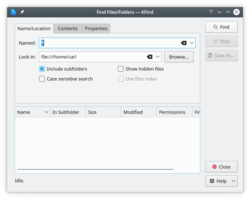KFind: Difference between revisions
(Markup edit) |
mNo edit summary |
||
| (7 intermediate revisions by 4 users not shown) | |||
| Line 2: | Line 2: | ||
{|class="tablecenter vertical-centered" | {|class="tablecenter vertical-centered" | ||
|[[Image:Kfind.png|thumb|250px]]|| ||<translate>'''Find files by name, type or content'''</translate> | |[[Image:Kfind.png|thumb|250px]]|| ||<translate><!--T:1--> | ||
'''Find files by name, type or content'''</translate> | |||
|} | |} | ||
<translate> | <translate> | ||
'''KFind''' can be used as a standalone search tool, launched by '''[[Special:myLanguage/KRunner|KRunner]]''' or from your menu. It is also integrated into '''[[Special:myLanguage/Konqueror|Konqueror]]''' and '''[[Special:myLanguage/Dolphin|Dolphin]]''' as <menuchoice>Find File</menuchoice> in the <menuchoice>Tools</menuchoice> menu. | <!--T:2--> | ||
'''KFind''' can be used as a standalone file search tool, launched by '''[[Special:myLanguage/KRunner|KRunner]]''' or from your menu. It is also integrated into '''[[Special:myLanguage/Konqueror|Konqueror]]''' and '''[[Special:myLanguage/Dolphin|Dolphin]]''' as <menuchoice>Find File</menuchoice> in the <menuchoice>Tools</menuchoice> menu. Being equipped with a graphical user interface, it is often handier than the command line tool named find which requires advanced skills in instruction syntax formulation. | |||
<!--T:3--> | |||
A search is configured in a 3-tab window. | A search is configured in a 3-tab window. | ||
<!--T:4--> | |||
The <menuchoice>Name/Location</menuchoice> tab | The <menuchoice>Name/Location</menuchoice> tab | ||
* Specify a file name | * Specify a file name | ||
| Line 15: | Line 19: | ||
* Decide whether you want to also search sub-directories | * Decide whether you want to also search sub-directories | ||
* Specify whether the search should be case-sensitive | * Specify whether the search should be case-sensitive | ||
* Specify whether hidden files to be shown as well | |||
The | |||
<!--T:5--> | |||
The <menuchoice>Contents</menuchoice> tab | |||
* Select the file type to be search | * Select the file type to be search | ||
* Specify the search term | * Specify the search term | ||
| Line 23: | Line 30: | ||
* Should binary files be searched? | * Should binary files be searched? | ||
{{Note|A | <!--T:6--> | ||
{{Note|A <menuchoice>Contents</menuchoice> search is necessarily much slower than a filename search, so be as specific as you can when defining it.}} | |||
The Properties tab | <!--T:7--> | ||
The <menuchoice>Properties</menuchoice> tab | |||
* Find files by creation date | * Find files by creation date | ||
* Limit the criteria by age - e.g. "during the previous 2 hours" | * Limit the criteria by age - e.g. "during the previous 2 hours" | ||
| Line 31: | Line 40: | ||
* Limit the result to files owned by a specific user or group | * Limit the result to files owned by a specific user or group | ||
All criteria set will be honoured in your search - you are not limited to the specifications in one tab, so you could search for | <!--T:8--> | ||
All criteria set will be honoured in your search - you are not limited to the specifications in one tab, so you could search for any file in the directory /home or any directory below that, containing the word "Silkstone" which must be capitalized, and is owned by the group "Accounts". | |||
<!--T:9--> | |||
[[Category:Utilities]] | [[Category:Utilities]] | ||
[[Category:File Management]] | [[Category:File Management]] | ||
[[Category:Help]] | |||
</translate> | </translate> | ||
Latest revision as of 15:39, 17 April 2020
 |
Find files by name, type or content |
KFind can be used as a standalone file search tool, launched by KRunner or from your menu. It is also integrated into Konqueror and Dolphin as in the menu. Being equipped with a graphical user interface, it is often handier than the command line tool named find which requires advanced skills in instruction syntax formulation.
A search is configured in a 3-tab window.
The tab
- Specify a file name
- use wildcards * and ? in the name
- Specify a starting directory
- Decide whether you want to also search sub-directories
- Specify whether the search should be case-sensitive
- Specify whether hidden files to be shown as well
The tab
- Select the file type to be search
- Specify the search term
- it can be useful to have '*' set in the file name field in the Name/Location tab
- Select case sensitivity
- Should binary files be searched?
The tab
- Find files by creation date
- Limit the criteria by age - e.g. "during the previous 2 hours"
- Find files by size - e.g. "At Least 2 MB"
- Limit the result to files owned by a specific user or group
All criteria set will be honoured in your search - you are not limited to the specifications in one tab, so you could search for any file in the directory /home or any directory below that, containing the word "Silkstone" which must be capitalized, and is owned by the group "Accounts".

